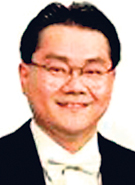The Symphony Orchestra of Sri Lanka's (SOSL's) Premiers Concert on October 18 at the Ladies' College Auditorium was a keenly awaited event. Guest conductor, Ms Keiko Kobayashi and two soloists, all from Japan, were star attractions; and for the first time, SOSL had a harpist in its midst as a concerto-soloist.
A broad and deep repertoire promised a passage of easy listening en route to a destination submerged in the most heroic and monumental in the world of music. Mozart's Flute and Harp concerto and "Rhapsody for Orchestra" by Japanese composer Toyama were in the first half of the programme, and, Beethoven's Fifth Symphony in the second half.
Endurance of Mozart's creativity
For the most part Mozart's life has been studded with tragedy, poverty, and indulgence; but ironically, periods of stark adversity were also junctures that unearthed his astounding creativity.
Though in 1778 (at the age of just 22) his Paris visit was to advance his career and finances, there wasn't joy for him in either respect.
 |
| Kimihiko Akiyama |
It's commonly held that Mozart detested the flute and the harp as they lacked the scope of the "keyboard". The Duke who commissioned a concerto for the flute and harp, showed no gratitude when it came to just compensation. He and his daughter were amateur musicians and Mozart was to make only moderate demands on their virtuosity.
Perhaps because of these circumstances, many critics of the concerto tend to categorize it as belonging to "lesser Mozart". Yet for much of the world it's a sinfonia concertante that is profound, gracious and adored thus vindicating Mozart's enduring creativity and the unshakeable faith in the beauty of his compositions among music lovers.
The harp, perhaps the oldest musical instrument, has an architecture that is sublime and otherworldly. For most in the audience the positioning of the music stand partly blocked the harpist's finger work and the side-on view of the instrument. Some in the audience had wished if there was a separate microphone to amplify its sound. Because the harp intrinsically has a muted, tonal quality, artificial amplification can spoil the unique textural effects and soft colours that a harp can render to the orchestra. For me, therefore, the sound level was right.
The first movement swung into brisk action in a chamber-music atmosphere. Flautist Kimihiko Akiyama, the more mature of the two soloists made his entry with authority after the orchestra's thematic statements. With a sweeping stroke on her harp the young-looking Ms Mayumi Mori added delicacy and momentum to the delightful partnership.
It was the role of the strings to introduce the andantino that was indeed rendered with alluring intimacy. The flute's sonority, particularly in the duets, penetrated the filigreed and fragile textures of the harp, though in the lower registers one could hear the harp doubling more assertively as a piano. The flute-harp partnership and the orchestra were ornamentally sumptuous with trills, dialogue and counterpoint.
The decorative if sensuous rondo finale was the most distinctively French. Though I would have preferred a slightly quicker tempo for the gavotte rhythm the overall rendering of the concerto was most elegant.
Japan's universality in music
Save for a brief period in the nineteenth century, Japan followed a policy that deliberately spurned European influences. That was till the second half of the nineteenth century when positions changed and European music gained acceptance. During and since the second half of the twentieth century Japanese composers, conductors and instrumentalists interacted globally and in the contemporary world they command international respect and recognition.
 |
| Keiko Kobayashi |
Yuzo Toyama as a composer has been influenced by the likes of Bartok, Shostakovich and Kodaly. Elements of Japanese folk melodies and traditional instruments feature eloquently in his compositions.
The Rhapsody's percussive beginning highlighted the Japanese wood clappers, temple bells and drums; the latter closely echoing the Sri Lankan tammettama in rhythmic patterns and tone quality. With inspired conducting and with only a sprinkling of traditional Japanese instruments, SOSL players created a dramatic, lively acoustic.
The rest of the Rhapsody was a series of melodies and orchestration using elements from Kabuki theatre, songs of fishermen, packhorse drivers, coal miners and festivals from diverse regions of Japan. A lyrically serene melody with muted strings, subtly evocative of the pentatonic refrains of the Sino-Japanese musical heritage, preceded a tumultuous conclusion.
The soul of humanity
American composer Charles Ives's allusion to the beginning of Beethoven's Fifth Symphony reads: "The soul of humanity at the door of the divine mysteries, radiant in the faith that it will be opened--and the human become the divine".
Beethoven's symphonic works owing to their commanding stature and a significant collection of great historical readings are by and large, the hardest and the most daunting music to conduct. To grapple at once with explosive ferocity, titanic grandeur, shattering drama as well as the pathos and triumph of his Fifth Symphony could be any conductor's nightmare.
The adjective "Premiers" in SOSL's concerts, I presume, is to convey that the occasion's repertoire is being performed for the first time. No one will fault SOSL for taking 51 years to open the door to Beethoven's Fifth Symphony. There was no question that Kobayashi was in complete command and for her there was a sense of occasion.
 |
| Mayumi Mori |
Whatever might be said about the challenge and the sense of occasion for the conductor, the Fifth Symphony turned out to be a pinnacle performance by Kobayashi and the SOSL.
What sets Beethoven apart is the creation of exceptionally wide and tempestuously shifting range of orchestral dynamics and skilful use of woodwinds, horns and brass to produce contrasting colours and textures. Despite seemingly disruptive dynamic punctuations, orchestral integration maintains the organic continuation of thematic progressions.
A major part of the first movement was a long-drawn engagement with the germinal "ta-ta-ta-Tah" first introduced by the strings and clarinets. The orchestra relentlessly saturated the ears of the listener with this phrase and its variants. It is a part of Beethoven's legacy that this motif has been implanted in the consciousness of every serious listener of the Fifth Symphony.
Kobayashi's intense energy levels were tirelessly sustained right through to the bold and thrusting finale of the massively affirmative movement. It heralded the symphony's unique culmination through a combination of features: the reprise of elements from earlier movements, expression of triumphant joy by a tortuous transition from the minor-key darkness to the C Major, and an elongated pounding coda that affirms the permanence of the destination.
If Kobayashi's loudness levels in the blaze and blare of the brass were a bit too brutal to my hearing, others in the audience might have felt otherwise.
I might not have had the privilege of listening to all the other Beethoven symphonies performed by SOSL. But the best I had witnessed before was the Seventh Symphony performed on February 15, 2003 under the baton of James Ross.
Inspirational Japanese
It's difficult for me to refrain from saying that SOSL's collaboration with Kobayashi in the Fifth Symphony outperformed all previous major works performed by SOSL thus far. It is in the context of the Fifth Symphony's extraordinary complexities that this view of mine is expressed. More generally, the entire concert was a great relationship between Kobayashi and SOSL.
What was most striking for me was Kobayashi's intense, disciplined and painstaking conducting; it bonded the players as never before and produced vivid and exhilarating sound.
"We certainly enjoyed playing under the baton of Keiko; it was an awesome experience" was the unsolicited and appreciative feedback a senior member of SOSL gave me after the performance. This augurs well for a rewarding and continuing relationship between SOSL, Kobayashi and sections of the Japanese music community.
There are no better examples than the Japanese when it comes to a disciplined work ethic and the pursuit of perfectionism and excellence. |



